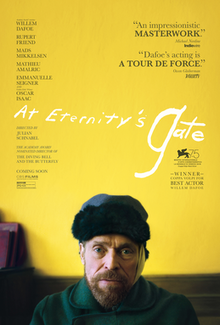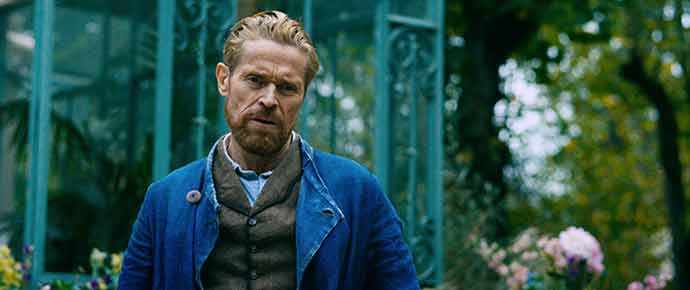← Back to Reviews

in
At Eternity's Gate
Willem Dafoe received his fourth Oscar nomination and his first for Outstanding Lead Actor for his performance in 2018's At Eternity's Gate, a slightly pretentious, but handsomely mounted look at the artist Vincent Van Gogh, that takes a pointed look at the demons that tormented the celebrated artist, most importantly, did his talent match his passion.

The film opens with the artist taking a self-imposed exile to secluded areas in France called Arles and Auvers-Sur-Oise, where the artist seems to remove himself from reality and avoiding human contact if at all possible as he finds the privacy to pursue his passion, but finds his work conflicting with issues of religion and mental illness that find him and many others questioning his sanity. Of course, the film also looks at the relationship with his brother Theo and with fellow artist Paul Gaugin, who were apparently the only people with whom Vincent could communicate.

Let me start off by saying that I know little or nothing about art, Van Gogh, and have never seen any of the other films about him, the most famous of which is probably the 1956 melodrama Lust for Life that starred Kirk Douglas as Van Gogh and won Anthony Quinn an Oscar for his Paul Gaugin. Director and co-screenwriter Julian Schnabel (The Diving Bell and the Butterfly) has crafted a richly textured look at this tortured soul that displays reverence to its subject, but doesn't blindly protect whatever images there are out there about him.

The first scene between Vincent and his brother Theo, sensitively portrayed by Rupert Friend, suggests an almost incestuous overtone to their relationship. Vincent is ill and when Theo arrives, he climbs into bed with his brother and Vincent says that if he's going to die, he would like it to be in his brother's arms. There's a disturbing scene that starts at the film's opening and is revisited and concluded later where Vincent asks a young woman to pose for him and he gets very physical with her when she has trouble understanding exactly the way he wants her to pose.

What really seems to be Schnabel's underlying theme in presenting this artist's story is the possibility that as much as Van Gogh loved to paint, he might not have been very good at it. Prior to this film, I never knew that Van Gogh only sold a single painting during his lifetime. He seems to look for approval and validation of his talent through his relationship with Gaugin which he never really gets. It's also revealed that Gaugin was the real reason Van Gogh cut off his ear. I was pleased that Schnabel had the taste to have this happen off screen. Vincent always said he had to paint fast and catch the subject as quickly but Paul said it was more important to check the condition of the surface you're painting on which seemed to be the genesis of their never ending conflict. We also learn that Van Gogh was institutionalized twice and I have never seen this happen in a movie before, but during his second incarceration, he is released early because the staff feel there is nothing they can do to help him.

The real selling point of this movie is the delicately layered performance by Willem Dafoe that rivets the viewer to the screen and makes this movie seem a lot better than it really is. Few actors play unhinged better than Dafoe and he gets ample opportunity to prove that here, whether terrorizing and being terrorized by a group of school children, or trying to validate his existence to a priest, beautifully played by Mads Mikkelsen, Dafoe quietly and powerfully demands viewer attention and never makes the viewer regret this sometimes, slow, but ultimately rewarding film experience and with someone other than Dafoe in the starring role, I would have taken half a bag of popcorn off this rating, but Dafoe alone raises the bar on this one.
Willem Dafoe received his fourth Oscar nomination and his first for Outstanding Lead Actor for his performance in 2018's At Eternity's Gate, a slightly pretentious, but handsomely mounted look at the artist Vincent Van Gogh, that takes a pointed look at the demons that tormented the celebrated artist, most importantly, did his talent match his passion.

The film opens with the artist taking a self-imposed exile to secluded areas in France called Arles and Auvers-Sur-Oise, where the artist seems to remove himself from reality and avoiding human contact if at all possible as he finds the privacy to pursue his passion, but finds his work conflicting with issues of religion and mental illness that find him and many others questioning his sanity. Of course, the film also looks at the relationship with his brother Theo and with fellow artist Paul Gaugin, who were apparently the only people with whom Vincent could communicate.

Let me start off by saying that I know little or nothing about art, Van Gogh, and have never seen any of the other films about him, the most famous of which is probably the 1956 melodrama Lust for Life that starred Kirk Douglas as Van Gogh and won Anthony Quinn an Oscar for his Paul Gaugin. Director and co-screenwriter Julian Schnabel (The Diving Bell and the Butterfly) has crafted a richly textured look at this tortured soul that displays reverence to its subject, but doesn't blindly protect whatever images there are out there about him.

The first scene between Vincent and his brother Theo, sensitively portrayed by Rupert Friend, suggests an almost incestuous overtone to their relationship. Vincent is ill and when Theo arrives, he climbs into bed with his brother and Vincent says that if he's going to die, he would like it to be in his brother's arms. There's a disturbing scene that starts at the film's opening and is revisited and concluded later where Vincent asks a young woman to pose for him and he gets very physical with her when she has trouble understanding exactly the way he wants her to pose.

What really seems to be Schnabel's underlying theme in presenting this artist's story is the possibility that as much as Van Gogh loved to paint, he might not have been very good at it. Prior to this film, I never knew that Van Gogh only sold a single painting during his lifetime. He seems to look for approval and validation of his talent through his relationship with Gaugin which he never really gets. It's also revealed that Gaugin was the real reason Van Gogh cut off his ear. I was pleased that Schnabel had the taste to have this happen off screen. Vincent always said he had to paint fast and catch the subject as quickly but Paul said it was more important to check the condition of the surface you're painting on which seemed to be the genesis of their never ending conflict. We also learn that Van Gogh was institutionalized twice and I have never seen this happen in a movie before, but during his second incarceration, he is released early because the staff feel there is nothing they can do to help him.

The real selling point of this movie is the delicately layered performance by Willem Dafoe that rivets the viewer to the screen and makes this movie seem a lot better than it really is. Few actors play unhinged better than Dafoe and he gets ample opportunity to prove that here, whether terrorizing and being terrorized by a group of school children, or trying to validate his existence to a priest, beautifully played by Mads Mikkelsen, Dafoe quietly and powerfully demands viewer attention and never makes the viewer regret this sometimes, slow, but ultimately rewarding film experience and with someone other than Dafoe in the starring role, I would have taken half a bag of popcorn off this rating, but Dafoe alone raises the bar on this one.
